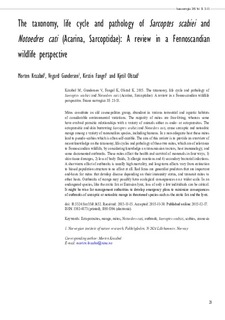The taxonomy, life cycle and pathology of sarcoptes scabiei and notoedres cati (Acarina, sarcoptidae): A review in a fennoscandian wildlife perspective
Journal article, Peer reviewed
Published version

Åpne
Permanent lenke
http://hdl.handle.net/11250/2572895Utgivelsesdato
2015Metadata
Vis full innførselSamlinger
- Publikasjoner fra CRIStin - NINA [2364]
- Scientific publications [1392]
Sammendrag
Kraabøl M, Gundersen V, Fangel K, Olstad K. 2015. The taxonomy, life cycle and pathology of
Sarcoptes scabiei and Notoedres cati (Acarina, Sarcoptidae): A review in a Fennoscandian wildlife
perspective. Fauna norvegica 35: 21-33.
Mites constitute an old cosmopolitan group, abundant in various terrestrial and aquatic habitats
of considerable environmental variations. The majority of mites are free-living, whereas some
have evolved parasitic relationships with a variety of animals either as endo- or ectoparasites. The
ectoparasitic and skin burrowing Sarcoptes scabiei and Notoedres cati, cause sarcoptic and notoedric
mange among a variety of mammalian species, including humans. In a non-adequate host these mites
lead to pseudo-scabies which is often self-curable. The aim of this review is to provide an overview of
recent knowledge on the taxonomy, life cycles and pathology of these two mites, which are of relevance
to Fennoscandian wildlife, by considering knowledge on transmission vectors, host immunology, and
some documented outbreaks. These mites affect the health and survival of mammals in four ways; 1)
skin tissue damages, 2) loss of body fluids, 3) allergic reactions and 4) secondary bacterial infections.
A short-term effect of outbreaks is usually high mortality, and long-term effects vary from extinction
to biased population structure to no effect at all. Red foxes are generalist predators that are important
end-hosts for mites that develop disease depending on their immunity status, and transmit mites to
other hosts. Outbreaks of mange may possibly have ecological consequences on a wider scale. In an
endangered species, like the arctic fox or Eurasian lynx, loss of only a few individuals can be critical.
It might be wise for management authorities to develop emergency plans to minimize consequences
of outbreaks of sarcoptic or notoedric mange in threatened species such as the arctic fox and the lynx.